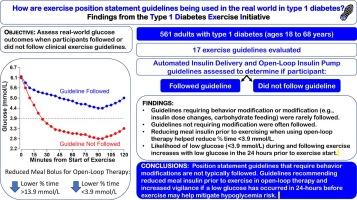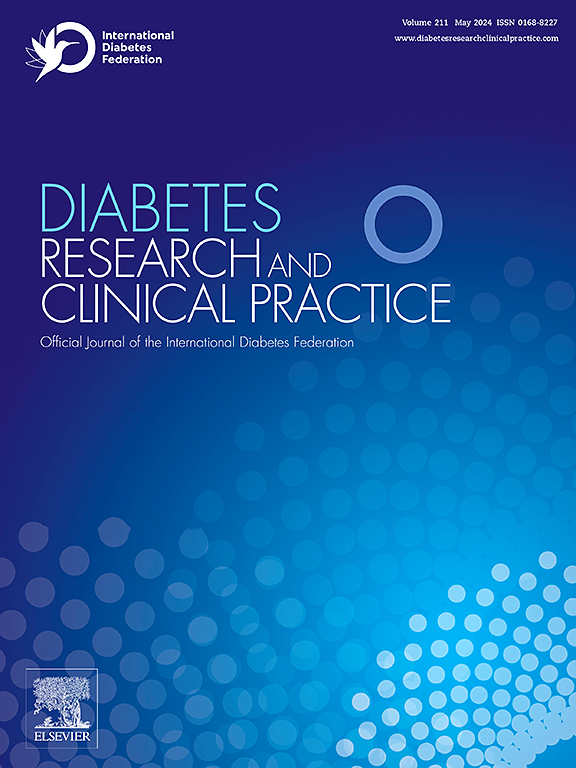评估 1 型糖尿病患者在现实世界中如何使用运动立场声明指南:1 型糖尿病运动倡议 (T1DEXI) 的研究结果。
IF 6.1
3区 医学
Q1 ENDOCRINOLOGY & METABOLISM
引用次数: 0
摘要
目的:立场声明指南应帮助 1 型糖尿病(T1D)患者改善运动时的血糖结果:在一项为期 4 周的观察研究中,收集了 561 名 1 型糖尿病成人患者的连续血糖、胰岛素和营养数据。对运动中、运动后和隔夜的血糖结果进行了计算,并对参与者使用与未使用开环(OL)和胰岛素自动给药(AID)疗法运动指南的情况进行了比较:结果:需要改变行为的指南很少被使用,而不需要改变行为的指南则经常被使用。建议在运动前减少餐后胰岛素用量的指南与较低的时间相关:自由生活数据集可用于评估立场声明指南的使用情况和益处。有证据表明,运动前减少餐后胰岛素用量且在之前 24 小时内未出现低血糖的 OL 参与者,其血糖低于范围值的时间较短。本文章由计算机程序翻译,如有差异,请以英文原文为准。

An evaluation of how exercise position statement guidelines are being used in the real world in type 1 diabetes: Findings from the type 1 diabetes exercise initiative (T1DEXI)
Aims
Position statement guidelines should help people with type 1 diabetes (T1D) improve glucose outcomes during exercise.
Methods
In a 4-week observational study, continuous glucose, insulin, and nutrient data were collected from 561 adults with T1D. Glucose outcomes were calculated during exercise, post-exercise, and overnight, and were compared for sessions when participants used versus did not use exercise guidelines for open-loop (OL) and automated insulin delivery (AID) therapy.
Results
Guidelines requiring behaviour modification were rarely used while guidelines not requiring modification were often used. The guideline recommending reduced meal insulin before exercise was associated with lower time <3.9 mmol/L during exercise (−2.2 %, P=0.02) for OL but not significant for AID (−1.4 %, P=0.27). Compared to exercise with low glucose (<3.9 mmol/L) in prior 24-hours, sessions without recent low glucose had lower time <3.9 mmol/L during exercise (−1.2 %, P<0.001). The AID guideline for no carbohydrates before exercise when CGM is flat, or increasing, was not associated with improved glycaemia.
Conclusions
Free-living datasets may be used to evaluate usage and benefit of position statement guidelines. Evidence suggests OL participants who reduced meal insulin prior to exercise and did not have low glucose in the prior 24 h had less time below range.
求助全文
通过发布文献求助,成功后即可免费获取论文全文。
去求助
来源期刊

Diabetes research and clinical practice
医学-内分泌学与代谢
CiteScore
10.30
自引率
3.90%
发文量
862
审稿时长
32 days
期刊介绍:
Diabetes Research and Clinical Practice is an international journal for health-care providers and clinically oriented researchers that publishes high-quality original research articles and expert reviews in diabetes and related areas. The role of the journal is to provide a venue for dissemination of knowledge and discussion of topics related to diabetes clinical research and patient care. Topics of focus include translational science, genetics, immunology, nutrition, psychosocial research, epidemiology, prevention, socio-economic research, complications, new treatments, technologies and therapy.
 求助内容:
求助内容: 应助结果提醒方式:
应助结果提醒方式:


